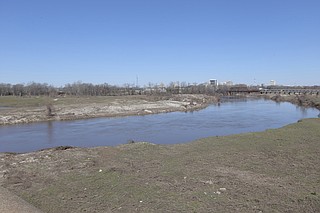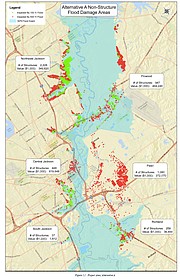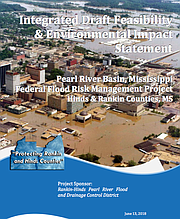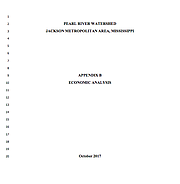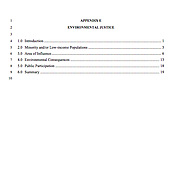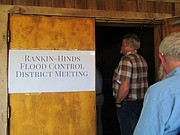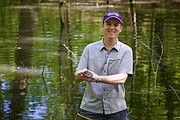Wednesday, August 22, 2018
The “One Lake” plan on the Pearl River could be a good idea, but the way forward cannot be through shrouding it in secrecy and avoiding public comment, questions or open debate of such a large public-works project. Photo by Imani Khayyam.
Rosie Smiley is used to her street in the Hightower neighborhood in south Jackson flooding in the spring. Some years the water will be 6 to 8 inches deep, like it was last year, and it tends to stick around for about a week.
Hightower is nestled south of Highway 80, about a mile west of the Pearl River that snakes past the capital city, dividing Hinds and Rankin counties in two. Hightower has a handful of businesses, churches and older houses on streets with no sidewalks, and about as many vacant lots and abandoned houses as occupied ones. The State of Mississippi owns some of the property; the City of Jackson owns other lots.
When Smiley first moved in around 2010, she bought about three truckloads of dirt and poured concrete in other places to protect her house and yard from the water when it floods. Her house is on short stilts as well. They are about eight bricks high.
"It was like we were on a little island (before the dirt)," Smiley said recently.
If the "One Lake" flood-control and development plan goes forward, her house will likely be in a voluntary buy-out area, where project sponsors will offer to buy the property of the residents and some business owners because their homes and buildings will continue to flood despite the project.
Smiley had not heard about "One Lake" before the Jackson Free Press approached her in early August for this story. She said she does not have flood insurance.
"I like this area, but if the flood came up way high, you have to move out," she said. "Every time the flooding came up, it makes the houses ragglier."
The Rankin-Hinds Pearl River Flood and Drainage Control District, often called the Levee Board, is supporting the "One Lake" plan, the latest version of a years-long strategy to create a lake development along the Pearl River through Jackson. Oilman John McGowan and partners have long supported and funded various blueprints that combine both flood control and development potential, but have met numerous obstacles along the way, from environmental to costs to public efficacy concerns. "One Lake" is the most modest plan to date.
McGowan started the nonprofit Pearl River Vision Foundation in 2000, secretary of state records show, and it has raised funds to help develop the latest proposal.
"One Lake" would reduce flooding levels in the Hightower neighborhood as well as others in downtown and northeast Jackson, Flowood, Pearl and Richland, the recently released draft Environmental Impact Statement for the project says.
No 'Easter Flood' Prevention
The EIS report, released in June after five years of work, shows that the majority of low-income and minority populations the project affects are in Jackson. Besides Hightower, the Levee Board would offer residents in the River Road Subdivision and Canton Avenue Estates in south Jackson voluntary buy-outs as a part of the "One Lake" plan. Downtown minority-owned businesses south and east of where Highway 80 and State Street meet also could choose a buy-out, as well as some businesses and residences in Flowood and Richland.
The "One Lake" project does not include mandatory buy-outs, however, so residents will not be forced to relocate out of areas at high flooding risking.
On Easter 1979, the Pearl River crested at more than 43 feet, marking a 500-year rarity (called a .5 percent annual chance exceedance flood event), in the Jackson metro. The Mississippi Coliseum parking lot looked like its own lake, and several downtown businesses flooded—and subsequently closed up shop.
Levee Board members and project sponsors, like the Pearl River Vision Foundation, have used the flood to push their "One Lake" plan as the most feasible option for flood control in the area and are not playing up the development potential of new waterfront property it would create as much as they did with prior versions.
The plan is not designed for a 500-year flood event, however, but up to a 100-year flood event. So, while it will provide some flood control to any property in a current flood zone, it would not accommodate identical flooding levels as the infamous "Easter flood" because it would have required a much larger footprint. "Designing for the annual 1 percent chance exceedance flood event allowed for the consideration of plans that reduce flood elevations and provide flood risk management yet encompass smaller project footprints," the engineering appendix to the report says.
In other words, if planned to accommodate "1979 Easter" flood-levels, the "One Lake" plan would have had a more adverse environmental impact. The plan, as proposed, will dredge (deepen and widen) the Pearl River channel in a 10-mile stretch along Jackson, Flowood, Pearl and Richland riverbanks, creating a 1,500-acre lake.
The plan would move the weir, which is currently located at "Waterworks Curve" just east of Belhaven, south to below Interstate 20. The architects envision using dredged material to create islands as well as new banks along the river—land for recreational use and economic development.
The project is estimated to cost more than $345 million, the draft report estimates. It would mean decreased flooding levels ranging from 2 to 8 feet within the project area, defined as the portion of the Pearl River that flows between Jackson and Rankin County, where Flowood, Pearl and Richland touch the river basin.
Residents of northeast Jackson, where McGowan lives in the Eastover neighborhood, appear to benefit the most from the project, the draft EIS shows, because they have the most to lose in another 500-year flood event. Most of the structures that 100-year flood conditions would affect are north of Lakeland Drive in Jackson.
In fact, the planners axed alternative lake options in the past even though they would have benefited northeast Jackson even more due to their negative environmental impacts.
A Lack of Details
The actual flood-control district limits are not spelled out in the study—and they will not be—until the U.S. Army Corps of Engineers in Washington, D.C., approves the project. Currently, the district is based on a 2007 map, which includes residents in Rankin and Hinds counties who live in the flood basin of the Pearl River.
The district would have to expand to capture more taxpayer revenue to help fund the project, however, likely including more Jacksonians. The 2007 district map contains mostly Rankin County.
The Mississippi Legislature gave the Levee Board taxing authority in 2017 to "levy a special improvement assessment that applies only to property in the district that is directly or indirectly benefited by the project to provide funds for the operation, maintenance and preservation of the project."
How a person is directly or indirectly benefitted as well as whose property is considered inside the flood-control district lines will not be determined until later, however.
"Once we have a project approved, and we're moving forward with preconstruction engineering and design—when we're in that phase is the time we'll begin the process for district expansion," board attorney Keith Turner told the JFP.
The new district's residents would get flood-control benefits, and thus pay the taxes, he said, adding that the process to expand it will include public participation through a notice and comment process.
The draft EIS was a long time in coming, but the design details are fuzzy in the report, when they are included at all. It mentions three adaptive management plans that will later spell out how the district intends to mitigate wetlands they are removing for project construction, for instance, but no details are in the draft EIS.
"We have the concept scoped out of where and what we want to do, but until we get to finalizing and implementing it, we don't have those details," Turner said.
The draft EIS spells out how engineers, working for the sponsors, achieved the concept for the "One Lake," but the design specifics will not be final until later.
Cost-Effective?
The "One Lake" project's estimated cost of more than $345 million, the draft EIS shows, is less expensive than other alternatives also examined: a total buy-out of homes and structures in the floodplain and a levee construction plan. The draft EIS estimates the levee plan to cost more than $729 million, while the buy-out plan would cost more than $2 billion.
District taxpayers will cover the costs of some of the project, but not all. The report includes cost estimates and percentages of how much the district, the State or the U.S. Congress would pay, but project sponsors were hesitant to confirm those numbers or say they were anything but estimates.
"It's premature to be sitting here having a discussion about 25 percent or 40 percent or 50 percent about anything because there are a lot of variables going into the financing of this thing, and it's kind of premature to be getting into the details of that," Turner told the Jackson Free Press.
The draft EIS says the flood-control district is responsible for 35 percent of preconstruction costs and 35 to 50 percent of total construction costs. If these estimates are correct, the district will be on the hook for between $121 million and $168 million of the more than $345-million price tag of the project. The projected annual cost to maintain the "One Lake" project is more than $600,000 a year.
Last year, Mississippi lawmakers killed bond legislation to fund some of the project, the federal Water Resources Development Act of 2016 already authorizes the project. The legislation gives congressional approval to the projects contained in it, including the "One Lake" project, but does not guarantee funding for it in the bill.
The "One Lake" project falls under "Section 211" of the Water Resources Development Act, meaning the sponsors could write their own report and that the process for project approval is much more flexible than traditional Corps projects.
Ultimately, the federal government can reimburse project planners up to a certain amount, once approved.
The flood-control district already received state funding through a $200,000 Mississippi Development Authority grant to help finance the studies that went into creating the draft EIS. Turner said counting from when the district started the project five years ago, the Levee Board has spent under $3 million on the studies.
Funds beyond state or local tax dollars to pay for the "One Lake" project will have to come from federal financing, if and when Congress approves the funding.
Environmental Trade-Off?
"One Lake" will have environmental consequences. The plan would affect more than 2,500 acres of vegetation, including the removal of 1,800 acres of wetlands that provide natural flood control along the Pearl River banks currently. The dredged material would fill that space instead, and in some parts, parks or other development would go on top of the new riverbanks. The draft EIS shows plans for camping loops, public parks, paved walking trails and other development along the Pearl's banks.
The plan is to "revegetate" the fill areas after construction is finished. "Given the extent of the project construction activities, the direct, adverse impacts to the vegetation resources within the Project Area are considered major in intensity and long-term in duration," the draft EIS says. "Mitigation measures, including habitat restoration activities, will help offset the intensity of these impacts during and after the construction activities are completed."
Abby Braman, the Pearl Riverkeeper and a member of the Waterkeeper Alliance, says her main opposition is the plan to rip out the natural wetlands and replace them with dredged material.
"To me that is not flood control; that is basically you're burning down the house in order to remodel the kitchen," she said. "You're destroying all of the natural flood and drainage control that is naturally there, and you're just creating more development and more impervious surfaces."
In Braman's view, cities along the Pearl need more local flood control to begin with. Impervious surfaces, like streets and sidewalks, make flash flooding in Jackson a problem—which the "One Lake" project is not designed to help. She said local flooding can be mitigated in different ways.
"Every citizen in the city of Jackson needs to have a rain barrel. They need to have ways to soak up the current run-off they have off of the concrete jungle that is Jackson," she said. "All of this water is flooding down into these tributaries and will continue to do so."
The flood-control district is not developing a plan to mitigate flash flooding in the Jackson area or flooding of tributaries that feed into the Pearl River. "One Lake" would not help flash floods after severe thunderstorms such as those in Jackson on Aug. 12. The project is designed to prevent the Pearl specifically from reaching high flood stages—not the creeks or tributaries.
"One Lake" could potentially threaten endangered species that have habitats in the Pearl River. The report lists the ringed sawback turtle, the gulf sturgeon and the Northern long-eared bat as three species potentially found in the project area.
Gulf sturgeon, which spawn up and down the river, are not common in the project area. However, the draft EIS says project planners will have to develop an adaptive management plan to show how the fish will get up and downstream. Study engineers mentioned a fish passage, a separate stream that works its way around the weir, as a part of this plan when speaking to Louisiana lawmakers last week.
The project would have to "include monitoring functions and the ability to provide alternative measures and/or structures that would insure that the Gulf sturgeon migration into and through the Project Area is available, post-project construction," the draft EIS says.
If Millsaps College biologist Will Selman's turtle survey data are correct, the project cause a localized extinction of the ringed sawback turtle habitat, affecting around 1,000 turtles, causing a localized extinction. The draft EIS makes no mention of Selman's survey, but project planners say they will create a mitigation plan in order to preserve habitats for the turtle population that live in and around the project area.
The long-eared bat might be using the forests along the banks of the Pearl River as a summer habitat currently, and the construction of "One Lake" would destroy much it. Sponsors are open to having adaptive management plans to control for and help endangered species in the area.
Nationally, the Trump administration unveiled a proposal in July to weaken the Endangered Species Act, and how those changes play into mitigation and management plans on "One Lake" is uncertain.
Smaller Footprint, Big Money?
John McGowan's last plan for the Pearl, "Two Lakes," faced heavy scrutiny because he, his partners and family members, as well as a Levee Board member, owned prime real estate that could become developable waterfront property. This time around, the sponsors of "One Lake" are promoting the project as primarily for flood control—not economic development.
However, the draft EIS says the "One Lake" plan maximizes the National Economic Development benefits. It states that the project has a smaller footprint than the "plan from 2007," but still maximizes economic-development benefits.
By expanding the shorelines with the dredged soil, the Levee Board will control valuable riverfront property, some of which would become public parks, they say. The report has conceptual models for multipurpose walking trails, RV and camping loops, an amphitheater and boat ramps to increase river access. Two landfills in Jackson could be built over with parks—not buildings—due to waste guidelines. The draft EIS lists the recreational benefits of "One Lake," including boating, fishing and canoeing.
"There will be a shift, to a degree, in the types of recreational opportunities that are available post-construction with the significant shift in habitat with the channel improvements," the draft EIS says.
"At the same time, overall recreational activities, primarily those that are water-dependent, would increase."
Currently, the proposed project area has one point to access the river, north of the weir on the Jackson side, and the levees are officially blocked off to public access. Who will get to develop on the new riverfront property, outside the public parks, will depend on what the district does with the property it acquires as a part of the project and what covenants the flood-control district establishes.
The draft EIS alludes to how the land use will be controlled. "Design considerations would be incorporated within the Alternative C project implementation to help avoid or minimize the overall significant of the direct, adverse impacts to the existing aesthetics and visual resources within the project area," the report says. "Covenants would be utilized to help control land use and development along the riverfront and provide an additional level of protection for the viewscapes within the area."
Past lake plans would have significantly benefited McGowan, who owns McGowan Working Partners next to the river, as well as the Pearl River Vision Foundation, which thus far has acted as the Levee Board's right-hand man on "One Lake."
Duane O'Neill, president of the Greater Jackson Chamber Partnership, said his organization has been involved with the project since its conception. The chamber has more than 1,000 member businesses in Hinds, Rankin and Madison counties primarily. O'Neill said the project is important primarily because of flood control and believes that another 1979 flood—which "One Lake" would not address—would mean more than $1 billion in damages to local businesses and properties.
"It now would be so much more devastating because of the build-out on Lakeland," O'Neill said. "The downtown area would be underwater."
He said most of his business members in the floodplain have flood insurance now, but the project would bring many of them out of certain flood zones or keep them from having to have insurance at all. He also noted that some businesses close to the new lake will likely increase in value.
"Everybody's property that is that close is going to increase in value, and you won't have to have flood insurance—not like you do today—so I actually think it's a huge plus," he told the Jackson Free Press.
O'Neill also sees the lake as an opportunity to make Jackson's downtown area like that of Chattanooga or Oklahoma City, with a blend of recreational and business development.
"The millennials and the young people we lose to Nashville and Chattanooga and all these other places, if you had something like that.... I think we could keep some of our young folks, and that talent that escapes from our community," he said.
Beyond land-use and riverfront development, questions of flood control for properties placed right along the river's edge are not addressed to date.
While some properties will be moved out of the 100- or 500-year flood zone because of the project, other property built along the river's edge would presumably be in some sort of flood danger, eventually.
In mid-August, Turner told Louisiana lawmakers, who are concerned about the effects downstream of development along the water's edge, that now it would be at levee height, not down on the river's edge.
Environmental groups and activists who oppose the project do not support development along the Pearl for flood control, mainly due to the river's nature.
As Selman wrote in a column for the Jackson Free Press in July, "The Pearl River is strong and quite predictable. ... It is going to flood. However, we don't know the magnitude of future floods, so it is possible that another big one will happen."
Storms Brewing Downstream
Downstream communities all the way to Louisiana and the Mississippi Gulf Coast have expressed concerns about any lake project along the Pearl, including "One Lake." Technically, the project has received federal clearance for the Jackson area, meaning the two downstream public meetings were not required for this project, although sponsors made the effort anyway.
The draft EIS authors also wrote about downstream risks. Using historical gage data, which measure river height above a reference point, the draft EIS refutes the idea that the Ross Barnett Reservoir, which is upstream 10 miles of the Pearl to the project, has affected the river flow downstream.
"Because a gate will accompany the weir structure as described in Alternative C, low flows downstream of the proposed improvements will not be impacted," the draft EIS says. "... [A] 440,000 acre foot impoundment (the Ross Barnett Reservoir) has had positive effects as evidenced by minimal increases across most years. Therefore, it is not anticipated that a 15,000-acre foot project, as proposed with continuation of the same minimal flows as released by the upstream reservoir, would impact any downstream conditions."
The key to flows will come from how the weir gate is engineered to regulate river flows. Despite the report's assurances, the State of Louisiana is mounting a solid effort to vocalize its concerns about the project. The Louisiana Pearl River Taskforce is gearing up to submit a large public comment, with letters from several state agencies, before the public comment deadline Sept. 6.
Sen. Sharon Hewitt, a Louisiana Republican, is coordinating her state's response to the "One Lake" draft EIS, and at a meeting on Monday, Aug. 13, she said she expected a large crowd at the Slidell public meeting on Thursday, Aug. 16. Project sponsors estimate that about 250 people were at the Slidell meeting, receiving about a dozen public comments there.
Before the evening meeting in Slidell, Hewitt's committee heard from "One Lake" leaders, who explained the project and answered some lawmakers' questions.
On Thursday, Aug. 16, some Louisiana lawmakers expressed reservations about the project, in part due to what they already experience along the river with low flows or flooding, depending on the season.
Lawmakers in Baton Rouge were concerned about the effects that the Ross Barnett Reservoir has downstream. Adding another lake below it just compounds their concerns. State Rep. Melinda White, a Democrat from St. Tammany Parish, which has adamantly opposed previous iterations of Pearl lake proposals, pushed for Louisiana to have a seat at the table on making decisions along the Pearl.
"That's my request today and my ask, and I'm sure you understand that, because if somebody proposed a project up above your area, you would have the same questions for them. It would affect Ross Barnett; it would affect your proposal and all of us, if someone up above made the same efforts to do something on the Pearl River," she said.
"We're more than willing to have a conversation, and we envision an arrangement between the reservoir and this project as far as management goes, yes," Turner responded. "We are willing to sit down with whoever to discuss it as it goes forward."
White wanted more than a chat, however. "I don't want to just sit down. I want to be a part of the decision-making process for the future, not me per se, but some representatives of some sort from Louisiana be a part of those meetings," she said. "... Someone from Louisiana needs to be a part of that as well, so we better understand the impacts of the river as a whole."
Legally, however, the Levee Board only has responsibility and jurisdiction in the Jackson metro area. In order to make those types of adjustments to the board, Turner said, it would require coordination with state agencies because the district does not have the authority to make decisions about the Pearl outside its district lines.
Hewitt's committee will take all the state agency responses and bind them together to submit an official response from the State of Louisiana by Aug. 31.
Support and Resentment
The public meeting for metro Jackson about the "One Lake" project on July 24 was packed. Project sponsors estimate that 300 to 400 people filled the Sparkman Auditorium at the Mississippi Agriculture and Forestry Museum near the Pearl River.
The crowd was almost all at least 40 years old, and most older. Younger people in the auditorium were almost exclusively associated with the project workers.
Attendees sat almost silently through the 40-minute presentation about the new proposal. The question time afterward remained civil as well, a fact that was not guaranteed before the meeting.
"I'll be back at my table, to be cussed out (after the presentation)," Abram Orlansky, an attorney for the project, said prior to the start of the meeting.
There was no cursing, however, likely due to how the meeting was structured. The project's sponsors opted to not have an open public comment period with questions and answers or open dialogue, instead asking people with questions to come up and ask them face-to-face to the report authors. Anyone wanting to submit a public comment at the meeting had to say it to a stenographer, but one-on-one conversations with report authors were not recorded. Only three people at the Jackson meeting submitted comments.
Anyone can submit a public comment online to the levee board at rankinhindsflooddistrict.ms.gov through Sept. 6.
Not everyone was pleased with the meeting format. "They changed it from a public forum to a propaganda machine," Jackson resident Rachel Knall told the Jackson Free Press at the meeting on July 24. "When you've got money involved, you usually get one side. I'm tired of big money being myopic."
The meeting was not supposed to be a debate, project sponsors said; it was supposed to answer questions. "I've heard from a lot of people who liked it," Turner told the Jackson Free Press at the meeting.
Braman asked Turner prior to the meeting if there was going to be a public comment period, and initially he said there would be. Then before the meeting, the website updated to say that the format had changed "due to logistical issues."
"We really could not facilitate it any other way than the way we did it," Turner said. "... It's the most effective way, otherwise you're going to have to put time limits on speakers. ... This is an opportunity for folks to get efficient, effective communication. It would have taken us six to eight hours to get through things."
The meeting format was identical at the Pearlington, Miss., meeting, and in Slidell, La.
Braman and other members of the "One River, No Lake" Coalition pointed out that most community members would not be aware of some of the potential issues with the project unless questions were posed in an open format. The "One River, No Lake" Coalition intends to submit a signed petition (which so far has over 2,000 signatures) to allow public comments in an open forum on the project before the comment period closes on Sept. 6.
What's Next for 'One Lake'?
With the Sept. 6 deadline for public comments looming, some advocates are frustrated that project sponsors released the report without what are called biological assessments and coordination reports done on the project. Braman said she wanted to see those reports in the actual draft EIS to help her write her public comment. She probably will not get the chance, however.
Turner said they did not have to release them as a part of the study because "we didn't rely upon them to do the EIS." He said he does not anticipate those documents being published until after Sept. 6.
Those reports must be included in the final version that goes to Washington, D.C., but before then, sponsors are required to respond to each public comment in their draft as well as any concerns that independent reviewers had with the project. Once they have responded to all these concerns, the draft goes to the D.C. Corps of Engineers. The Corps then determines whether or not to approve the final EIS. If approved, it will be released for public comment again. After that public comment period, then pre-construction can begin.
Construction (with full funding) is estimated to take about three years, but financing—or potential lawsuits downstream, by environmental groups or residents concerned about financial or other potentially harmful effects—could make that process much longer. After the D.C. Corps approves the project, the Levee Board still needs to enlarge the actual district, roping in more taxpayers who will presumably get the flood-control benefits and therefore will be forced to help pay to build it.
From there, either the U.S. Army Corps of Engineers or the Levee Board can take the lead, and Turner said that has not been worked out yet. The district must clear its first hurdle first: responding to all the public comments submitted about the draft EIS, which could take all fall.
Meantime, even in neighborhoods prone to flooding, residents are skeptical that they will ever benefit from a plan designed for both flood control and economic development in Jackson.
Ruby Vingham was born 67 years ago in the Hightower neighborhood in the same house where she still lives.
If "One Lake" moves forward and the flooding risk increases, Vingham said she is not sure she would take a buy-out. Instead, she would probably stay in her house and face whatever happens.
She said it does not matter what she thinks about the "One Lake" proposal. "They're going to do what they want to do, no matter what I say," Vingham said.
Read the history of various lake proposals at jacksonfreepress.com/pearlriver.
